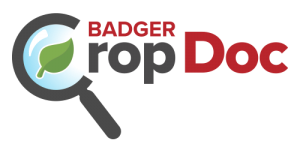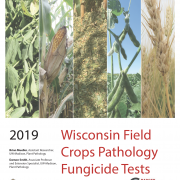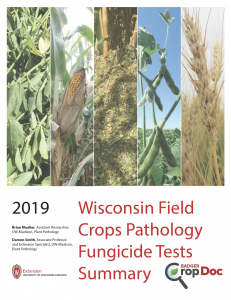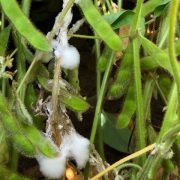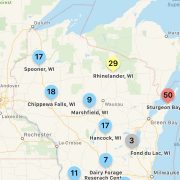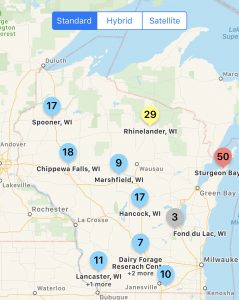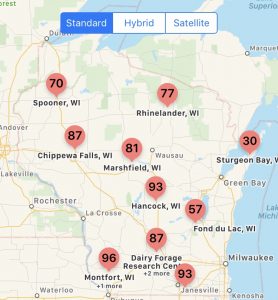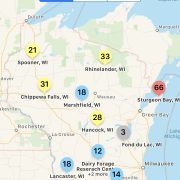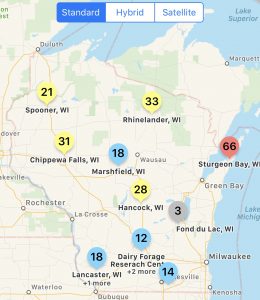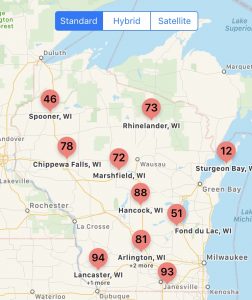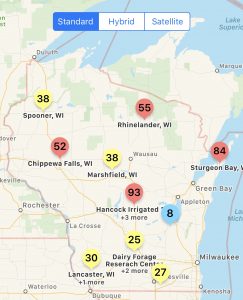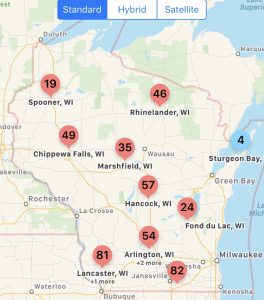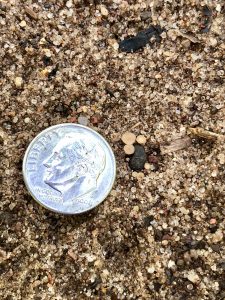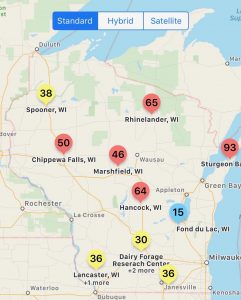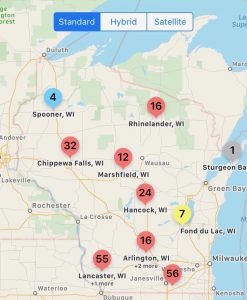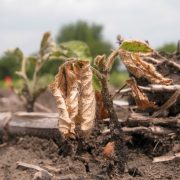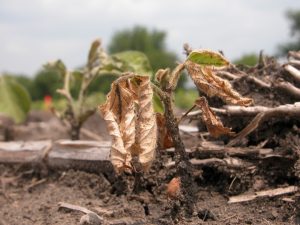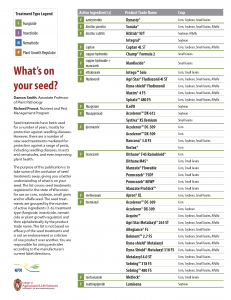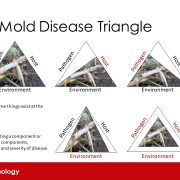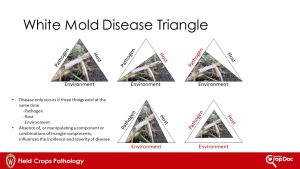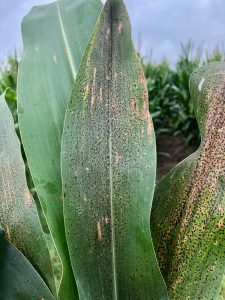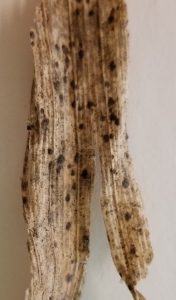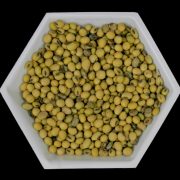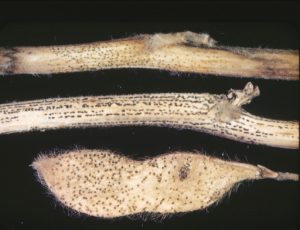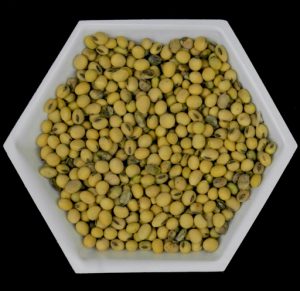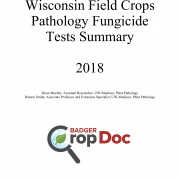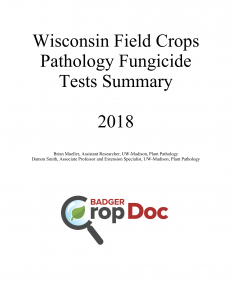Damon L. Smith, Associate Professor and Extension Field Crops Pathology Specialist, University of Wisconsin-Madison
Shawn P. Conley, Professor and Extension Soybean and Small Grains Agronomy Specialist, University of Wisconsin-Madison
As the days get shorter and the temperatures start to cool, soybean harvest is on everyone’s minds. As the crop is maturing and beginning the early stages of drydown, calls about diseases are starting to come in. In the southern third of the state most of the calls have centered on sudden death syndrome or SDS. To the north, most questions pertain to Sclerotinia stem rot or white mold. Below we will discuss SDS in some detail and provide a brief update on the white mold situation as well as elaborate on seed decay issues that we should pay attention to as we begin harvest.
Scout for Sudden Death Syndrome (SDS)
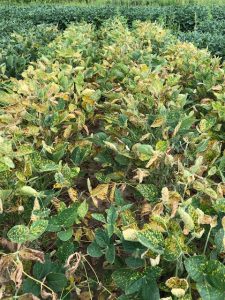
Figure 1. Symptoms of sudden death syndrome on soybeans
The first noticeable symptoms of SDS (Fig. 1) are chlorotic (i.e., yellow) blotches that form between the veins of soybean leaflets. These blotches expand into large, irregular, chlorotic patches (also between the veins), and this chlorotic tissue later dies and turns brown. Soon thereafter entire leaflets will die and shrivel. In severe cases, leaflets will drop off leaving the petioles attached. Taproots and below-ground portions of the stems of plants suffering from SDS, when split open, will exhibit a slightly tan to light brown discoloration of the vascular (i.e., water- conducting) tissue. The pith will remain white or cream-colored. In plants with advanced foliar symptoms of SDS, small, light blue patches will form on taproots and stems below the soil line. These patches are spore masses of the fungus that causes the disease.
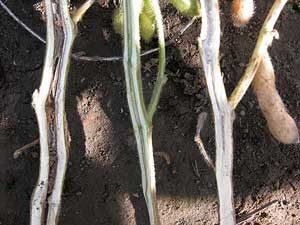
Figure 2. Symptoms of BSR in soybean stems compared with a healthy soybean stem in the center.
Foliar symptoms of SDS can be confused with those of brown stem rot. However, in the case of brown stem rot (BSR), the pith of affected soybean plants will be brown (Fig. 2). In addition, roots and lower stems of plants suffering from BSR will not have light blue spore masses.
Once symptoms of SDS are evident, yield losses are inevitable. Yield losses can range from slight to 100%, depending on the soybean variety being grown, the plant growth stage at the time of infection and whether or not SCN is present in a field. If SDS occurs after reproductive stages (R5 or R6) impact on yield is usually less compared to the development of SDS at flowering, which can lead to substantial yield losses. When SCN is present, the combined damage from both diseases can be substantially more than the sum of the damage expected from the individual diseases.
SDS is caused by the soilborne fungus, Fusarium virguliforme (synonym: F. solani f. sp. glycines). F. virguliforme can overwinter freely in the soil, in crop residue, and in the cysts of SCN. The fungus infects soybean roots (by some reports as early as one week after crop emergence), and is generally restricted to roots as well as stems near the soil line. F. virguliforme does not invade leaves, flowers, pods or seeds, but does produce toxins in the roots that move to the leaves, causing SDS’s characteristic foliar symptoms.
SDS cannot be controlled once plants have been infected. Foliar fungicides have NO effect on the disease. Recently a new seed treatment has been identified that has efficacy against SDS. The active ingredient fluopyram can be found in the seed treatment iLeVo and is rated “very good” in multi-state trials. Other methods of control include using SDS-resistant varieties whenever possible in fields with a history of the disease; however, keep in mind that SDS-resistant varieties with maturity groups suitable for Wisconsin and other northern regions (groups I and II) can be limited. If SDS and SCN are both problems in the same field, planting an SCN-resistant soybean variety may also be beneficial in managing SDS. Do not delay planting soybeans to avoid symptoms of SDS. In Wisconsin, it has been demonstrated that the benefits to yield when planting early outweigh the benefits of reduced SDS symptoms if planting is delayed. Improve soil drainage by using tillage practices that reduce compaction problems. Rotation, while useful in managing other soybean diseases, does not appear to significantly reduce the severity of SDS. Even after several years of continuous production of corn, F. virguliforme populations typically are not reduced substantially. Research from Iowa State University has shown that corn (especially corn kernels) can harbor the SDS pathogen.
For more information CLICK HERE to download a full color fact sheet on SDS. A short video on SDS can also be viewed by CLICKING HERE.
Know Where White Mold is in 2019
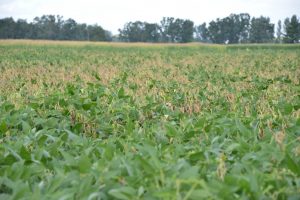
Figure 3. White Mold in a Soybean Field
Symptoms of white mold (Fig. 3) are becoming pretty apparent in some parts of central and northern Wisconsin. White fluffy growth (mycelium) is readily evident over the last week while weather has been humid and wet. Incidence in the northern half of the state is high in some fields. Fields in the northeast and northwest corridors of the state seem to be hardest hit, but severity is highly variable from one field to the next. This is likely due to a combination of variety and micro-environments that can influence the disease. Most of the soybean crop is at the R6 growth stage, with some earlier maturing fields are almost through R7 or have made it to R8. Now the question is how much soybean yield might I lose from white mold?
Research has demonstrated that for every 10% increase in the number of plants that are infected with white mold at the R7 growth stage, you can expect between 2 to 5 bushels of yield loss. Thus, fields with low levels (say 3% incidence) will likely experience no detectable yield loss while fields with 20% incidence could lose as much as 10 bushels per acre.
What should I do if I see white mold in my soybean field now?
The first step is to get out and survey your fields for white mold. It is a good idea to determine how much white mold you have in your fields, so you can make some educated harvest decisions. One way to move white mold from one field to the next is via combines. You could clean your combine between each field, but this can be time consuming. So by determining which fields have no white mold and which fields have the most white mold, you can develop a logical harvest order by beginning your harvest on fields with no white mold and working your way to the heavily infested fields. This will help reduce spread of the white mold fungus to fields that aren’t infested. You can also make some decisions on your rotation plan and future soybean variety choices based on these late season observations.
If you would like to learn more about white mold and management of this disease, CLICK HERE to download a fact sheet from the crop protection network. You can also watch a short video about white mold by CLICKING HERE.
Watch for Phomopsis Seed Decay at Harvest
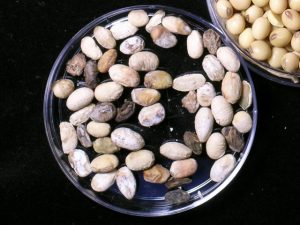
Figure 4. Severe Phomopsis seed decay. Photo Credit: Craig Grau, University of Wisconsin-Madison.
If you remember the 2018 harvest season, you are probably having nightmares right now. Extended rainy periods in October significantly delayed harvest and subjected the standing soybean crop to significant seed decay issues. Watch out for rainy periods during the 2019 harvest. If we end up in these wet patterns again in 2019, we could have a repeat of poor seed quality going into 2020.
What does Phomopsis seed decay look like?
The fungus that causes Phomopsis seed decay (Fig. 4) can infect soybean plants early in the season and colonize pods and infect seeds near, or at maturity. Infected seed will often be shriveled or undersized and can have a white or chalky appearance. If pods are opened in the field a white cottony “mold” (different than that of white mold) can be observed. Infected seed can pass the Phomopsis seed decay fungus on in seedlings of the next soybean crop. Therefore, it is important to identify Phomopsis seed decay especially in soybean-seed fields.
What conditions are favorable for Phomopsis seed decay?
Warm and wet weather during pod fill and maturity favor the development of Phompsis seed decay. The conditions have been prevalent in areas of Wisconsin in 2019, especially where planting was delayed. Soybean varieties that mature early are also more prone to Phompsis seed decay. Other stresses such as nutrient deficiencies or virus infections can also increase the occurrence of Phompsis seed decay. Infested seed is a likely source of Phompsis seed decay, however, the fungus can survive on soybean debris and certain weeds like velvetleaf.
How should I handle soybeans with Phomopsis seed decay?
Scout fields before harvest to get an idea of how much Phomopsis seed decay you might have in a field. Scout multiple plants in at least 5 locations in a field, opening pods to determine if Phomopsis seed decay is present. In fields where Phomopsis seed decay is observed, harvest should be prioritized as soon as combines can enter the field. Seed infected with the Phomopsis seed decay fungus will continue to rot in the pod until they are harvested.
How should I manage Phomopsis seed decay in the 2020 soybean crop?
Soybean seed producers should try to clean seed to achieve less than 20% damaged seed in a seed lot. Multiple cleaning steps might be needed to achieve this level. While testing germination now is recommended, remember that testing germination again next spring and potentially just prior to delivery will also help you to understand the germination rate and determine if other management strategies need to be employed such as fungicidal seed treatments.
Seed treatments can help improve the germination rate of seed damaged by Diaporthe. However, you will need more than metalaxyl or mefonoxam active ingredients in your seed treatment. Metalaxyl and mefonoxam are good against Phytophthora and Pythium, but not effective against other organisms, like Diaporthe. Seed treatments with Phomopsis on the label have an additional fungicide (either a DMI or SDHI). Table 3-8 of the publication A3646 – Pest Management in Wisconsin Field Crops has a table of some of the seed treatments with Phomopsis on the label. Also available, as stated above, is the seed treatment efficacy table from the Crop Protection Network (CPN). You can download that publication by clicking here.
As farmers begin to look forward to the 2020 growing season we also recommend that you double check the percent germination on every seed lot prior to planting and adjust your seeding rates accordingly. Here are our recommendations for soybean seeding rate based on yield potential and white mold risk: The Soybean Seeding Rate Conundrum.
An Additional Phomopsis Seed Decay Resource
A fact sheet about Pod and Stem blight and Phomopsis seed decay has been developed by a consortium of soybean extension pathologists. You can download that fact sheet by clicking here.
